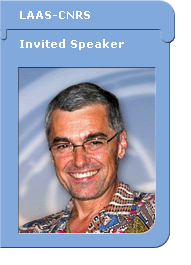
Motion planning for PLM: State of the Art and Perspectives
How can a robot autonomously decide how to perform a motion task while respecting environment constraints such as obstacle avoidance ? This is the question addressed by algorithmic motion planning an active research area born 25 years ago with robot applications.
The first part of this talk will sketch the mathematical formulation of the problem and present a state of the art of the methods developed in the 80s (deterministic approaches) and the 90's (probabilistic approaches and nonholonomic systems). A special focus will be done on random sampling and random diffusion methods. Such methods are today mature enough to give rise to software packages addressing large classes of problems and applications in PLM, beyond robotics.
The scope of applications is the purpose of the second part of the talk. Practical problem illustrations and demonstrations will be given in various domains of PLM:
- Manufacturing (spot welding robot programming)
- CAD/CAM Design (mechanical part assembly in automotive industry)
- Process Engineering (maintenance operation in nuclear powerplants)
- Mobile Robotics (transportation of the Airbus A380 components by road, Hilare and its trailer, rovers on rough terrains)
- Bio-Engineering (molecular docking and protein folding)
- Animation and Graphics (human artefact animation)
- Video Games and Network Technology (motion compression)
Jean-Paul Laumond is Directeur de Recherche at LAAS-CNRS (group RIA) in Toulouse, France. He received the M.S. degree in Mathematics, the Ph.D. in Robotics and the Habilitation from the University Paul Sabatier at Toulouse in 1976, 1984 and 1989 respectively. From 1976 to 1983 he was teacher in Mathematics. He joined CNRS in 1985. In Fall 1990 he has been invited senior scientist from Stanford University. He has been a member of the French Comité National de la Recherche Scientifique from 1991 to 1995. He is currently a member of the board of the ACI Neurosciences Intégratives et Computationnelles.
He has been coordinator of two the European Esprit projects PROMotion (Planning RObot Motion, 1992-1995) and MOLOG (Motion for Logistics, 1999 - 2002), both dedicated to robot motion planning technology. In 2001 and 2002 he created and managed Kineo CAM, a spin-off company from LAAS-CNRS devoted to develop and market motion planning technology. Kineo CAM was awarded the French Research Ministery prize for innovation and enterprise in 2000.
He teaches Robotics at ENSTA and Ecole Normale Supérieure in Paris. He has edited three books. He has published more than 100 papers in international journals and conferences in Computer Science, Automatic Control and Robotics.